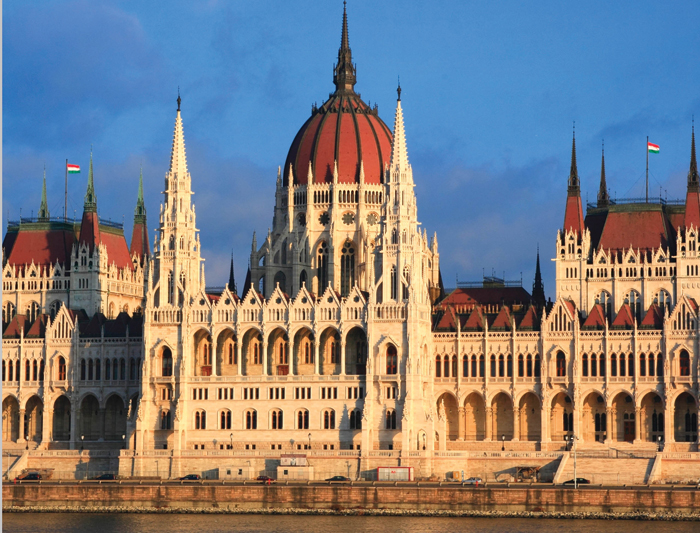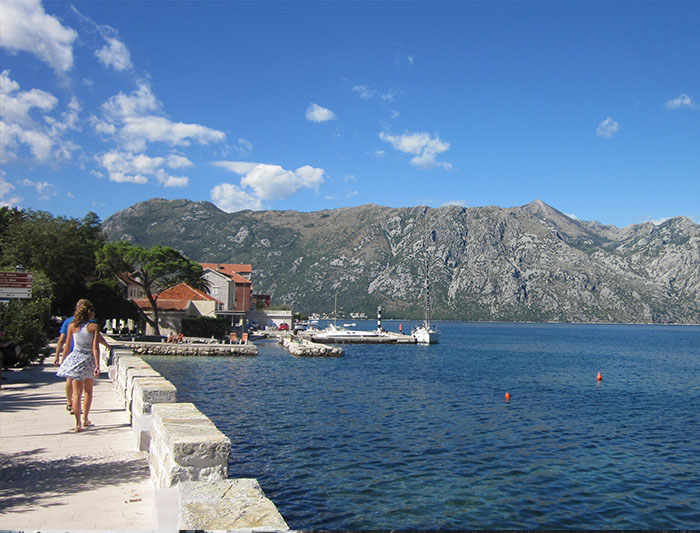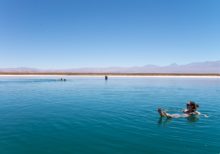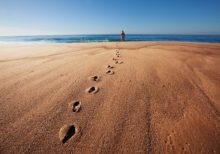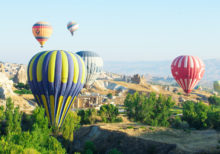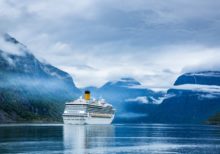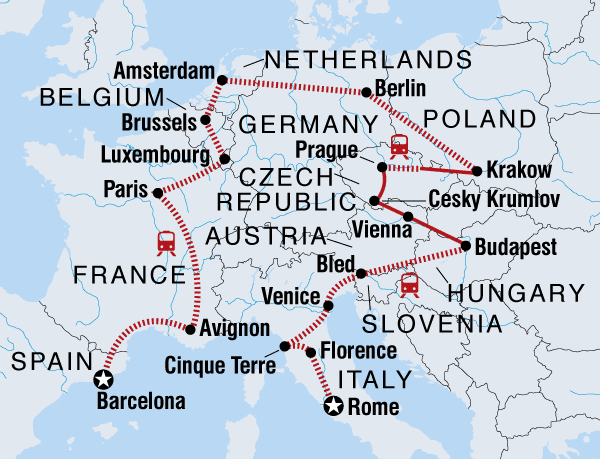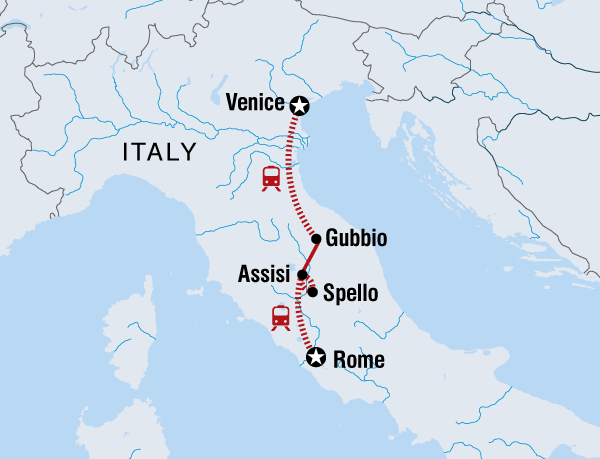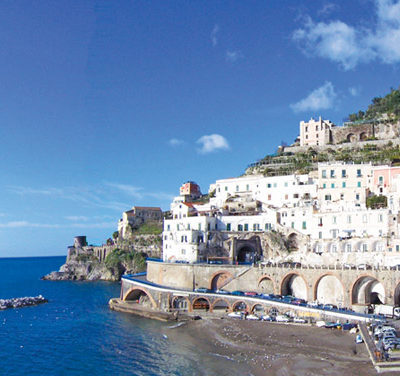| Starts | Budapest, Hungary |
|---|---|
| Ends | Venice, Italy |
| Region | Hungary |
| Duration | 19 days |
| Tour Operator | Intrepid Travel |

Itinerary
Day 1 - Starting: Budapest & Finishing: Budapest
Szia! Welcome to Hungary. Budapest is Hungary's intoxicating capital, on the banks of the Danube River. Your adventure begins with a welcome meeting at 6pm today. You can arrive at any time during the day as there are no activities planned until this important meeting. Please check with the hotel reception about where and when it will take place, or check the reception notice boards. If you can't arrange a flight that will have you arrive at the hotel by early evening, you may wish to arrive a day early so you're able to attend. We'll be happy to book additional accommodation for you (subject to availability). If you're going to be late, please inform the hotel reception. We'll be collecting your insurance details and next of kin information at this meeting, so please ensure you have all these details to provide to your leader. In the evening after the welcome meeting perhaps head out with your new travel buddies and your leader for dinner, then take a night walk along the Danube River to see the surrounding buildings and bridges lit up in lights. Not to be missed are Budapest's funky 'ruin pubs'.
Day 2 - Starting: Budapest / Overnight Train & Finishing: Budapest / Overnight Train
This morning you have the option to join your leader on a short orientation walk of the city. Afterwards you have a full free day to explore Budapest, known as 'The Pearl of the Danube'. Admire intricate carvings on resplendent buildings, cross the iconic Chain Bridge to explore the Castle District, or simply meander through winding streets snacking on local delicacies. Budapest is a great city to enjoy from the water. Perhaps take a boat trip along the river or catch a funicular up to the castle for spectacular views of the Parliament Building. With so much to see and do, hiring a bicycle is another great way to move between the sights. Perhaps head to Statue Park to see the communist monuments that were removed from the city after the fall of the Iron Curtain. You might like to take a tour of the beautiful Hungarian State Opera House, or check out the Hungarian National Museum. One unmissable activity is a soak in the healing waters of Budapest's hot thermal baths. You could also take part in one of our Urban Adventure day tours, such as the Budapest Explorer or Bites and Sights. Check them out at urbanadventures.com. In the evening, board an overnight train to Belgrade.
Day 3 - Starting: Belgrade & Finishing: Belgrade
This morning arrive into Belgrade after your overnight train journey. Known as the' White City', Belgrade is one of the oldest cities in Europe. Sitting at the confluence of two major rivers, the Sava and the Danube, it’s an important intersection between Eastern and Western Europe. Here you’ll experience an energetic mix of progressive flamboyance and conservative customs. Upon arrival there is the option to join a guided tour. Then you'll have almost two full days of free time to explore the city. Perhaps begin with a wander around the city’s wide boulevards and squares, and the historic and green heart of Kalemegdan Park. The park is home to Kelmegdan Fortress, which has overlooked the Danube River here for centuries. In the evening, head down to Skadarska Street in the bohemian quarter of Skadarlija to sample some authentic local food and enjoy the lively atmosphere, in a place where Orthodox churches vie for space next to fashionable nightclubs.
Day 4 - Starting: Belgrade & Finishing: Belgrade
Today is a free day to further discover Belgrade. You might like to take a 90-minute cruise along the Danube River, passing the Kalemegdan Fortress, Pancevo Bridge and the artist village of Zemun. The markets near the Hram Svetog Save (St Sava Church) will keep you occupied for hours. Perhaps take a stroll through the Nikola Tesla Museum to learn about the life and work of Serbia's greatest inventor, or check out the city's Ethnographic or Military Museums. You can climb the 36-metre, 1896 Gardos tower in Zemun for sweeping views of the city and the Danube, or get crash course in Serbian contemporary art at Zepter Museum. If the weather is warm, why not brave the crowds on Ada Ciganlija beach, where you can swim, take part in water-sports or simply soak up the sun with a cocktail. Throughout the summer months, Belgrade hosts a variety of musical and cultural events and the city is abuzz with people and activities. The city’s nightlife has become legendary throughout Europe, with several hundred floating bars, restaurants and nightclubs lining the Danube and Sava rivers.
Day 5 - Starting: Sarajevo & Finishing: Sarajevo
Travel by bus through beautiful countryside to Sarajevo. The journey will take around eight hours in total, so sit back and enjoy the scenery. Sarajevo is Bosnia and Herzegovina's small but vibrant capital. More than twenty years after the end of a devastating war, Sarajevo is slowly asserting itself as one of Europe's most beautiful and interesting destinations. The city often draws comparisons with Istanbul as a place that mixes east and west – dotted with minarets, mosques, bazaars and the aroma of coffee. On arrival, perhaps embark on a guided tour to gain insight into the history and culture of the city. Sarajevo is one of the few cities in the world that features an Orthodox church, a Catholic church and a mosque (the famous Begova Džamija) all within close proximity. In the evening, perhaps enjoy a simple but delicious meal in Baščaršija, Sarajevo's old bazaar. Out from here the city’s history unfolds – from Ottoman-era buildings to the elaborate constructions of the Austro-Hungarian period and on to the ugly structures of the communists. Try the local speciality of bosanski cevapi (grilled minced meat mixed with mild spices).
Day 6 - Starting: Sarajevo & Finishing: Sarajevo
Enjoy a free day in and around Sarajevo. You could take an optional day trip out to the thermal springs and green parks of Ilidza, the source of the River Bosna. You might prefer to discover local history with a visit to the History Museum and the Sarajevo War Tunnels (dug underneath the airport runway and used to smuggle provisions into the city during its siege) and Sniper Alley, or learn about the tragedies faced by the city's Jews at the Jewish Museum. Perhaps get cultural with a stroll through the Art Gallery of Bosnia and Herzegovina. Perhaps return to Baščaršija and get lost in the mosques, caravanserais, and stone-vaulted bazaars, snacking on burek or ćevapi, or ramble along through Park Prinčeva for views of the city. The Pivnica HS brewery, which also has a restaurant, is a good place to sample local award-winning beer and spend an evening.
Day 7 - Starting: Mostar / Kotor & Finishing: Mostar / Kotor
Head out of Sarajevo by bus to Mostar, a town situated in a beautiful valley in the high mountains of Herzegovina (approximately 2.5 hours). Thanks to the river Neretva Mostar was able to develop as a city in the barren landscape of Herzegovina. Neretva's size turned Mostar into a trading centre of the region very early on. The city was the most heavily bombed settlement in Bosnia during the war, but it has since been rebuilt and now features on UNESCO's World Heritage list. On arrival, perhaps head to the famous Stari Most (meaning Old Bridge), first built by the Ottomans in 1565 – it was the great architect Mimar Hajrudin who succeeded with the impossible mission to cross the Neretva River with a single span stone bridge. The bridge also made headline news during the Yugoslav wars when it was destroyed in 1993. It was rebuilt and reopened in 2004, and there’s an interesting museum about its history next to the bridge itself. If you’re lucky you’ll see the famous brave members of Mostar’s diving club hurl themselves into the icy waters below. It’s a tradition for the young men of the town to make the jump, and it’s now an annual competition. We advise against having a go yourself though, as the bridge is very high and the water is freezing. You might like to follow local custom and hand the divers a few Marks. Later on today continue to Kotor where you will spend the night.
Day 8 - Starting: Kotor & Finishing: Kotor
Explore Europe's most southerly fjord, Boka Kotorska (Bay of Kotor), and enjoy an orientation walk around Kotor town, with free time to explore by yourself for the rest of the day.This 5th-century World Heritage-listed city is set on a secluded bay, with towering peaks surrounding a rocky coastline dotted with pretty waterside towns. Check out the 12th-century Cathedral of St Tryphun, the South Gates of Kotor (the Gurdich Gate) and the Armoury Square (Trg od oruzija). Afterwards, you might like to get delightfully lost in the crooked alleyways, checking out the boutiques and cafes, or climb the hills behind the city to visit Kotor's ruined fortification walls. A one-and-a-half hour hike up the stone steps, past churches, gates, and bastions to the Fortress of Sveti Ivan at the top rewards you with magnificent views across town and the brooding Bay of Kotor. In the evening the city walls are prettily lit up to provide a unique night-time perspective.
Day 9 - Starting: Dubrovnik & Finishing: Dubrovnik
Depart Montenegro by bus, riding along the beautiful southern coast of Croatia to Dubrovnik (approximately 2 hours). The day is free for you to explore Dubrovnik at your own pace. Take a walk along the city walls of ‘Game of Thrones’ fame, enjoying views of the sparkling Adriatic Sea in this renowned jewel of the Dalmatian Coast. Visit Big Onofrio's Fountain, built by architect Onofrio della Cava in the 15th century to supply water to the city. Perhaps check out the 13th-century Franciscan monastery or the Sponza and Rector's Palaces, the only Renaissance buildings in the city to survive a devastating earthquake and fire in 1667. You might like to check out the city's War Photography Museum, or if you have time, even take a boat trip to nearby Lokrum Island, where you will find the French-built Fort Royal Castle, a monastery, and a botanical garden that dates back to when the Austrian archduke Maximilian had his holiday home on the island. At the end of your journey, perhaps you'd prefer to simply unwind on a beach. On the last night of your trip, why not enjoy one last meal with the group and toast to your adventures.
Day 10-11 - Starting: Dubrovnik & Finishing: Dubrovnik
You will have 2 free days to explore the beaches and scenery of this idyllic coastal city that overlooks the Adriatic. The walled city of Dubrovnik is a great place to discover on foot, with its cobblestone streets, tiled roofs, white washed walls and stone buildings. Stroll down the main street of Stradun that runs straight through the World heritage listed Old Town, with its baroque monuments and gothic buildingsDubrovnik. You might like to check out the city's War Photography Museum, or if you have time, even take a boat trip to nearby Lokrum Island, where you will find the French-built Fort Royal Castle, a monastery, and a botanical garden that dates back to when the Austrian archduke Maximilian had his holiday home on the island. Or perhaps you'd prefer to simply unwind on a beach. As this is a combination trip your group and the leader may change at this location. There will be another group meeting tonight and you are welcome to attend to get to know your new fellow travellers. After the meeting, perhaps head out for a walk around Dubrovnik and later on, possibly enjoy a meal with the new group.
Day 12 - Starting: Split & Finishing: Split
Take a public bus up the coast to Split (approximately 4,5 hours). If Dubrovnik is considered the heart of Dalmatia, Split is certainly its soul. Situated on a small peninsula on the eastern shores of the Adriatic Sea, it's the second largest city in Croatia. This stunning seaside town is home to some of the most beautiful beaches on the coast. Enjoy a free afternoon exploring the historic streets, and make sure you see the World Heritage-listed Diocletian's Palace. Alternatively for a more in-depth introduction to this fascinating city why not join an optional guided tour with a local guide. Split grew out from the 3rd century Roman Emperor Diocletian's Palace and you can almost see it evolving in a multitude of different ways. Some cultures might have made the palace a museum, but the city of Split has always been a dynamic and vibrant place, and the palace houses many businesses and homes. If your feet get tired, why not grab a drink at a cafe on the Riva Promenade and people watch for a while. You can get lots of local interaction in Split, such as at the fish market on Marmontova Street or the markets just outside the palace walls.
Day 13 - Starting: Split / Brac Island & Finishing: Split / Brac Island
Take a daytrip out to the island of Brac, the third largest of Croatia's islands and host to enchanting harbour villages, set among steep cliffs and a distinctly Mediterranean landscape. Villagers have farmed wine, olive oil, figs and almonds in the difficult interior of this rock-strewn island for centuries, but it's the small, beach-side towns that draw the crowds. Brac's most famous export is the gleaming white stone mined from the island's quarries, cladding buildings as deep in antiquity as Diocletian's Palace in Split, and as far afield as the White House in Washington DC. Visit the town of Supetar - your leader will show you around on an initial orientation walk. Spend a day exploring this island on your own steam, or simply take it easy, lie on the famous Zlatni Rat beach and enjoy the sun with a drink in your hand.
Day 14 - Starting: Plitvice Lakes National Park / Zagreb & Finishing: Plitvice Lakes National Park / Zagreb
Today you will visit one of Croatia's most beautiful sites – Plitvice Lakes National Park. The park was given World Heritage status 20 years ago and is 19 hectares of wooded hills that surround 16 stunning turquoise lakes, all connected by a series of waterfalls. The area is populated by deer, bears, wolves, boars and some rare bird species, and the thick, primeval forest vegetation of beech trees, fir spruce and white pine adds another element to the park's beauty. You’ll have free time to explore here or simply follow your leader to see the best spots – all trails in the national park are well marked so it's difficult to get lost, but please follow the national park rules, which your leader will outline to you. A series of wooden walkways pass over the landscape, ensuring that there's as little impact on the park as possible. Look to the canopy for over 120 species of birds, including hawks and owls. After your memorable visit to the lakes, drive to Croatia's capital, Zagreb. Take an afternoon orientation walk on arrival. Your leader will point out local amenities and attractions you might want to visit along the way, so ask any questions you might have about the city during the walk.
Day 15 - Starting: Zagreb & Finishing: Zagreb
Today is a free day in Zagreb, so check out both the upper town and the lower town to understand the city's culture. The tallest building in town is the gothic Zagreb Cathedral, with iconic twin spires that dominate the city's skyline. Ban Jelacic Square is the city's central point, which is surrounded by multiple structures that reflect different periods of Zagreb's past. There is so much to see and do here, the hard thing is deciding what to choose. There are a number of excellent museums to visit including the quirky Museum of Broken Relationships.
Day 16 - Starting: Ljubljana & Finishing: Ljubljana
Travel by train across the Slovenian border and arrive in the cosmopolitan capital (pronounced 'Lyub-Li-Yana') (approximately 2.5 hours). On arrival into Ljubljana, check in to your accommodation and then head out to get to know the city on a short orientation walk where the leader will point out some of the highlights. The rest of the day is free for you to delve deeper into this beautiful city. Located in the centre of Slovenia, Ljubljana is a city full of style and sophistication, history, monuments, churches, museums and great restaurants. In your free time, you can wander around the old city centre, renowned for its unique architectural appearance. The Old Town consists of three main squares and Baroque houses, and you can visit the Ljubljana Castle, the Town Hall, Cathedral of St. Nicholas, and the Dragon Bridge. Stop at the central Prešeren Square, dedicated to the Slovenian romantic poet, France Prešeren. With views of the Triple Bridge and Ljubljana Castle on one side, and a magnificent Franciscan church on the other, you’ll feel like you’ve just walked right into a scene from a beautiful postcard. Maybe also drop by the open market under the arcade. This evening enjoy Ljubljana by night.
Day 17 - Starting: Ljubljana & Finishing: Ljubljana
Today is a free day. You may want to decide to take an optional day trip to Bled. With immense natural beauty, Bled, together with its surroundings, ranks among the most beautiful of alpine resorts. With a stunning lake, a castle, a picturesque island church and plenty of outdoor activities, Bled is a great place to explore. It's renowned for its mild, healing climate and thermal lake water. Maybe head to the cliff-top Bled Castle, dating from the 11th century and overlooking sparkling Lake Bled, then take a Pletna boat ride (a wooden, awning-covered boat rowed by a special oarsman) to the island on Lake Bled – climb up the 99 steps to St Mary's Church. Be sure to seek out the famous Bled cream cake, which isn’t hard; nearly every cafe and cake shop in town claims that theirs is the best. There's also plenty of action for adrenaline junkies: rafting, caving, cycling, canoeing, boating, and swimming, to name a few.
Day 18 - Starting: Venice & Finishing: Venice
This morning travel by bus to one of the world's most unique cities, legendary, romantic Venice, the final destination of this trip (approximately 3.5 hours). A grand city of canals, Venice is built over a hundred small islands connected by 400 bridges. This watery wonderland of towers, piazzas, canals, churches and gondolas – practically unchanged for 600 years – is literally sinking under the weight of its iconic sights. Still rich with artistic masterpieces, modern Venice combines history with contemporary life through food, performance, art and architecture. The best way to enjoy your free time and explore is by foot, taking in all the famous sights – the Grand Canal, the Rialto Bridge, Doge's Palace (the ruler of Venice), the Piazza San Marco with its golden Basilica, and of course, the evocative Bridge of Sighs. Wander the cobblestone streets and spacious piazzas, crossing hundreds of tiny bridges. There are shops, markets, galleries and churches around every corner. Don't miss taking a gondola trip through the romantic canals or sampling a slice of region's desert speciality, tiramisu (coffee-soaked sponge cake). In the evening, perhaps join your fellow travellers for a final group dinner at a local restaurant. Venice is famous for its specialities of fresh lobster and squid ink spaghetti dishes, so make sure you give one a try as this trip comes to an end. Note: Please note that the accommodation we use in Venice is not located in the lagoon, but in the mainland suburb of Mestre, which is a short train ride away from the city centre and the lagoon of Venice.
Day 19 - Starting: Venice & Finishing: Venice
On the final day of the trip, there are no activities planned and you're able to depart the accommodation at any time. As there is so much to do in Venice we recommend you to extend your stay by a few days. We are happy to book additional accommodation for you, subject to availability. Please enquire at the time of booking.
View Dates

